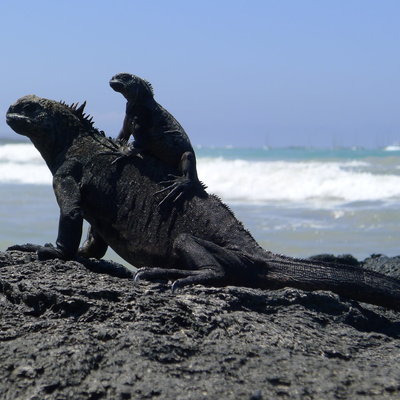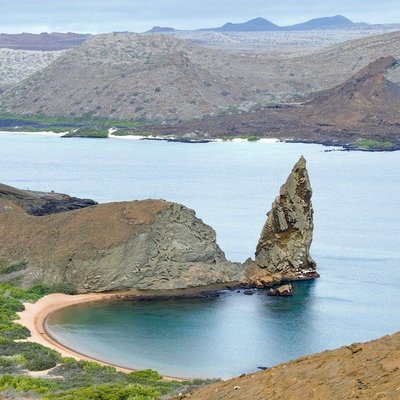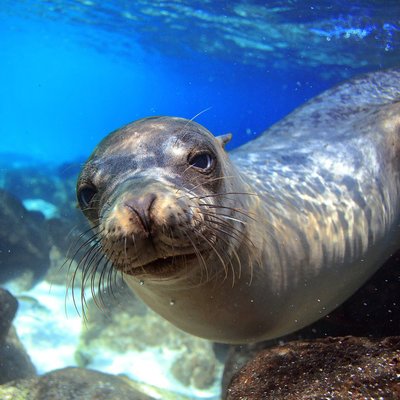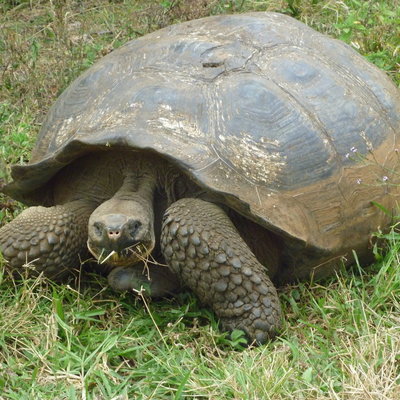GALAPAGOS ISLANDS
Are an archipelago of volcanic islands distributed on either side of the Equator in the Pacific Ocean, 906 km (563 mi) west of continental Ecuador, of which they are a part of.
The Galápagos Islands and their surrounding waters form the Galápagos Province of Ecuador, the Galápagos National Park, and the Galápagos Marine Reserve. The group consists of 18 main islands, 3 smaller islands, and 107 rocks and islets. Española Island, the southernmost islet of the archipelago, and Darwin Island, the northernmost one, are spread out over a distance of 220 km (137 mi).
The Galápagos Islands and their surrounding waters form the Galápagos Province of Ecuador, the Galápagos National Park, and the Galápagos Marine Reserve.
The islands are famed for their vast number of endemic species and were studied by Charles Darwin during the voyage of the Beagle. His observations and collections contributed to the inception of Darwin's theory of evolution by natural selection.
HISTORY & CULTURE
The first recorded visit to the islands happened by chance in 1535, when the Bishop of Panamá Fray Tomás de Berlanga went to Peru to arbitrate a dispute between Francisco Pizarro and Diego de Almagro. De Berlanga was blown off course, though he eventually returned to the Spanish Empire and described the conditions of the islands and the animals that inhabited them. The first crude map of the islands was made in 1684 by the buccaneer Ambrose Cowley, who named the individual islands after some of his fellow pirates or after British royalty and noblemen. These names were used in the authoritative navigation charts of the islands prepared during the Beagle survey under Captain Robert Fitzroy, and in Darwin's popular book The Voyage of the Beagle. The new Republic of Ecuador took the islands from Spanish ownership in 1832 and subsequently gave them official Spanish names.
In 1986, the 70,000 square kilometres (27,000 sq mi.) of ocean surrounding the islands was declared a marine reserve, second in size only to Australia's Great Barrier Reef. In 1990, the archipelago became a whale sanctuary. UNESCO recognised the islands in 1978 as a World Heritage Site and in 1985, as a biosphere reserve. This was later extended in December 2001 to include the marine reserve.
TYPES OF DIVING
Due to the wide scattering of the islands, nearly all dives are liveaboards. Wall dives, drift dives and drop-offs by tender is the norm. This area is very remote & due to this, you MUST be an advanced diver with over 50 dives. Conditions change with winds & currents. Please check your local Dive Shop to up-grade to an Advanced diver.
DIVE SITES
Punta Carrion on the west of Santa Cruz is the first stop for most liveaboards in the Galapagos. It is a thrill for naturalists with Galapagos sea lions dipping down to play with divers and shoals of eagle rays passing by. Underwater photographers will enjoy ample opportunities with white tip reef sharks which are numerous and very unwary of divers. If you are lucky you might also catch a glimpse of hammerheads and dolphins in the blue.
Wolf and Darwin are the most isolated of the Galapagos Islands and an overnight sail is required for liveaboards. These tiny islands are home to unique birdlife and land visits are not permitted. Very few boats are allowed to stop at Wolf and Darwin meaning you will likely only have to share the site with research boats there to tag and study the large Pelagics.
The underwater area around these islands is a highway for scalloped hammerheads heading for the Cocos. Silky Sharks and Galapagos Sharks and Manta Rays are also passing by. You also have a chance to see pods of Dolphins, Spotted Eagle Rays and even Orcas on occasion. There is also the chance to see the biggest fish in the world, the Whaleshark, between June and November.
Liveaboards are the only way to access Darwin and Wolf due to their isolated position.
Cabo Douglas is on the eastern side of Fernandina Island. Here you can see marine Iguanas, a species unique to Galapagos. These Iguanas can dive for up to ten minutes, feeding on algae growing on the rocks. There are also flightless Cormorants, Galapagos Penguins and Seahorses around Cabo Douglas. It is ideal for those who want to dive with unique animal species and underwater photographers will have ample subjects with good light.
Cousins Rock is a tiny rocky island on the north of Santiago Island. On land, it is inhabited by seabirds and sea lions. The underwater landscape is perfect for underwater photography with black coral, sponges and sea fans. It is also a prime spot to see Manta Rays passing by.
WHAT TO SEE DIVING
Diving in Galapagos is fantastic all year round but there are two distinct seasons.
Each has amazing opportunities to see huge schools of hammerhead sharks, Galapagos sharks, Silky sharks and Whalesharks in the season (July-Nov), in addition to other pelagic life like giant Manta Rays, eagle rays, sting rays, huge schools of jack and tuna, sea turtles, sea lions and more.
On Cabo Douglas, you can see marine Iguanas, a species unique to Galapagos. These Iguanas can dive for up to ten minutes, feeding on algae growing on the rocks. There are also flightless Cormorants, Galapagos Penguins and Seahorses around Cabo Douglas. It is ideal for those who want to dive with unique animal species and underwater photographers will have ample subjects with good light.
Whalesharks are the focus of the Galapagos Shark Diving Team, which is an expedition type trip.
DIVE CONDITIONS
There can be strong currents and cold water thermoclines. Divers should be Advanced or higher and have dived recently as the CONDITIONS CAN BE STRENUOUS. You need to be an Advanced Diver with a minimum of 50 dives. (This is to ensure your safety & ultimately be about your enjoyment, Diving is about being relaxed, stress-free, & comfortable.)
Diving in Galapagos can be cold especially in the cool season, and most liveaboards offer 3-4 unmissable dives per day. 7mm wetsuits and hoods are recommended for comfort. Gloves or a reef hook are a necessity. Strong currents mean holding onto rocks, which are almost always covered with sharp barnacles.
Visibility is variable all over the Galapagos but expect around 15-20 meters/33 ft.
WEATHER
The Galapagos Islands have a highly variable climate, as does Ecuador's mainland. There are two seasons in the islands: the hot/rainy season, from December to June, when humidity is high and average temperatures are in the 80s F (26°-30° C). There may be occasional showers, but the days are generally warm and sunny. Seas are generally calm.
From June to November, you can expect cool winds, occasionally bringing with them a light misty-type drizzle called "garúa." Temperatures average in the 70s F (20°-24° C) during the day and lower at night. Winds can cause choppy seas, especially in open water between the islands.
WATER TEMPERATURE
Although located on the Equator, the Humboldt Current brings cold water to the islands, causing frequent drizzles during most of the year. The weather is periodically influenced by the El Niño events, which occur about every 3–7 years and are characterized by warm sea surface temperatures, a rise in sea level, greater wave action, and a depletion of nutrients in the water.
During the season known as the garúa (June to November), the temperature by the sea is 22 °C (72 °F), a steady and cold wind blows from south and southeast, frequent drizzles last most of the day, and dense fog conceals the islands. During the warm season (December to May), the average sea and air temperature rise to 25 °C (77 °F), there is no wind at all, there are sporadic, though strong, rains and the sun shines.
AIR TEMPERATURE
There are two seasons in the islands: the hot/rainy season, from December to June, when humidity is high and average temperatures are in the 80s F (26°-30° C). From June to November, you can expect cool winds, occasionally bringing with them a light misty-type drizzle called "garúa." Temperatures average in the 70s F (20°-24° C) during the day and lower at night.
RAIN FALL
Rainfall varies from around 200mm in the dryer season and around 400mm in the wet or rainy season.
HOW TO GET THERE
Getting to Galapagos from Ecuador is relatively easy. Most flights are around a 2-hour transit from Guayaquil and Quito which both have international airports. The most frequent flights are with airlines LAN, Tame and Avianca. Be sure to give a few days extra when flying from Quito, volcanic activity around the city can cause delays.
Due to the highly protected nature of the Galapagos National Park visitors should bear a few things in mind before travelling. Before departure, you will have to pay for a departure/arrival card and have your bags be checked for biological contaminants.
Bringing any plants, seed or biological goods is forbidden and signing the card confirms this. If you are bringing hiking boots, make sure they are clean and have no plant material or seeds on them. These rules are to stop invasive species which are one of the biggest threats to the unique ecosystem of the islands. You will also have to pay a national park fee on arrival.
Options for flying into the Galápagos are limited to two islands; San Cristobal and Baltra.
Flights travel to the Galapagos in the morning and return in the afternoon, typically requiring a forced overnight on the continent in each direction.
VISA CONDITIONS
Ecuador welcomes tourists and travellers from every country. The Galapagos Islands are technically part of Ecuador so all visitors will need to arrange for a travel visa to Ecuador prior to visiting. Citizens of the US, the UK, Canada, Australia and several European nations are eligible for a free visa upon arrival in Ecuador. This tourist visa is valid for a stay of up to 90 days provided your passport is valid for at least six months past your date of entry into Ecuador.
It’s possible, but not likely, that immigration officials will ask to see a return plane ticket and proof of funds to support your stay. Travelers from all other countries should check with their local Ecuadorian embassy concerning specific visa requirements for nationals of their country.
At the airports, there is a booth where you obtain your "visa". This "visa" is really an Arrival/Departure Record Form which you fill out before getting to Galapagos. A pre-registry is needed.
NOTE: There is a separate $100 park entrance fee to pay when you land in Galapagos. Make sure you have the cash for that as they will not accept Visa.
LOCAL KNOWLEDGE
The water is about 6 percent saltier, so adjusting your weights to compensate for greater buoyancy is necessary.
Most liveaboards offer the opportunity to do land visits. These offer a unique insight into one of the world´s most biodiverse ecosystems are not to be missed.
GENERAL INFORMATION
Health and Safety
No specific vaccinations are required to visit the Galapagos Islands, but it is recommended that travellers are up to date with vaccinations against hepatitis A and B.
When travelling to any new part of the world, it’s advised to stick to bottled water, and in the case of the Galapagos Islands, be careful when eating shellfish and seafood.
There are really no safety concerns in the Galapagos Islands to worry about. Crime is virtually non-existent and the wildlife rarely appears interested in putting you on the dinner plate.
Your biggest concern when visiting the Galapagos Islands should be the health and safety of the creatures that live on the islands. It will be tempting, but avoid any contact with the animals. Do not feed, touch, chase or do anything more engaging than observe them. These wild Galapagos Islands creatures are a true rarity on our planet and should be left as they are.







